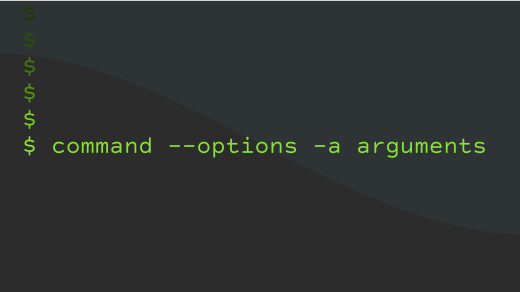Terminal commands usually have options or switches, which you can use to modify how the command does what it does. Options are included in the POSIX specification for command-line interfaces. It's also a time-honored convention established with the earliest UNIX applications, so it's good to know how to include them in your Bash scripts when you're creating your own commands.
As with most languages, there are several ways to solve the problem of parsing options in Bash. To this day, my favorite method remains the one I learned from Patrick Volkerding's Slackware build scripts, which served as my introduction to shell scripting back when I first discovered Linux and dared to venture into the plain text files that shipped with the OS.
Option parsing in Bash
The strategy for parsing options in Bash is to cycle through all arguments passed to your shell script, determine whether they are an option or not, and then shift to the next argument. Repeat this process until no options remain.
Start with a simple Boolean option (sometimes called a switch or a flag):
#!/bin/bash
while [ True ]; do
if [ "$1" = "--alpha" -o "$1" = "-a" ]; then
ALPHA=1
shift 1
else
break
fi
done
echo $ALPHAIn this code, I create a while loop which serves as an infinite loop until there are no further arguments to process. An if statement attempts to match whatever argument is found in the first position ($1) to either --alpha or -a. (These are arbitrary option names with no special significance. In an actual script, you might use --verbose and -v to trigger verbose output).
The shift keyword causes all arguments to shift by 1, such that an argument in position 2 ($2) is moved into position 1 ($1). The else statement is triggered when there are no further arguments to process, which breaks the while loop.
At the end of the script, the value of $ALPHA is printed to the terminal.
Test the script:
$ bash ./test.sh --alpha
1
$ bash ./test.sh
$ bash ./test.sh -a
1The option is correctly detected.
Detecting arguments in Bash
There is a problem, though: Extra arguments are ignored.
$ bash ./test.sh --alpha foo
1
$To catch arguments that aren't intended as options, you can dump remaining arguments into a Bash array.
#!/bin/bash
while [ True ]; do
if [ "$1" = "--alpha" -o "$1" = "-a" ]; then
ALPHA=1
shift 1
else
break
fi
done
echo $ALPHA
ARG=( "${@}" )
for i in ${ARG[@]}; do
echo $i
doneTest the new version of the script:
$ bash ./test.sh --alpha foo
1
foo
$ bash ./test.sh foo
foo
$ bash ./test.sh --alpha foo bar
1
foo
barOptions with arguments
Some options require an argument all their own. For instance, you might want to allow the user to set an attribute such as a color or the resolution of a graphic or to point your application to a custom configuration file.
To implement this in Bash, you can use the shift keyword as you do with Boolean switches but shift the arguments by 2 instead of 1.
#!/bin/bash
while [ True ]; do
if [ "$1" = "--alpha" -o "$1" = "-a" ]; then
ALPHA=1
shift 1
elif [ "$1" = "--config" -o "$1" = "-c" ]; then
CONFIG=$2
shift 2
else
break
fi
done
echo $ALPHA
echo $CONFIG
ARG=( "${@}" )
for i in ${ARG[@]}; do
echo $i
doneIn this code, I add an elif clause to compare each argument to both --config and -c. In the event of a match, the value of a variable called CONFIG is set to the value of whatever the second argument is (this means that the --config option requires an argument). All arguments shift place by 2: 1 to shift --config or -c, and 1 to move its argument. As usual, the loop repeats until no matching arguments remain.
Here's a test of the new version of the script:
$ bash ./test.sh --config my.conf foo bar
my.conf
foo
bar
$ bash ./test.sh -a --config my.conf baz
1
my.conf
bazOption parsing made easy
There are other ways to parse options in Bash. You can alternately use a case statement or the getopt command. Whatever you choose to use, options for your users are important features for any application, and Bash makes it easy.









Comments are closed.